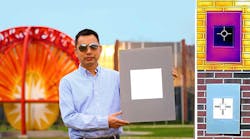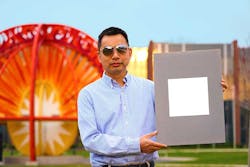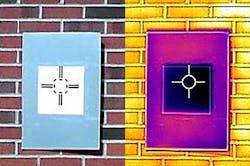To save energy, engineers at Purdue University have developed a paint that is whiter than any other, which means it reflects more light. Putting it on roofs and sides of buildings will keep those buildings cool and reduce the need for air conditioning.
“If you covered a roof of about 1,000 square feet with it, you could get 10 kilowatts of cooling power, which is more than the central air conditioners found in most houses,” says Xiulin Ruan, a mechanical engineering professor at Purdue.
The new paint reflects up to 98.1% of visible and infared sunlight. When painted on a surface, it can make it cooler than the surrounding air. Typical commercial white paints get warmer rather than cooler. Paints on the market designed to reject heat reflect only 80% to 90% of sunlight and can’t make surfaces cooler than their surroundings.
In tests, the paint kept surfaces 19°F cooler than their ambient surroundings at night. It also cooled surfaces 8°F lower than the surroundings under strong noontime sunlight. The paint’s solar reflectance is so effective, it even worked in the middle of winter during an outdoor test.
The new ultra-white paint seems to be on the opposite end of the spectrum as Vantablack, a coating that has been dubbed “the blackest black.“ Vantablack, invented by Surrey NanoSystems, absorbs up to 99.9% of visible light.
The key to the new coating’s ability is its high concentrations of barium sulfate, a chemical used to make photo paper and cosmetics white.
“We looked at various commercial products—basically anything that’s white,” says Xiangyu Li, a postdoctoral who worked on this project as a Purdue Ph.D. student in Ruan’s lab. “We found that barium sulfate can make things really, really reflective, which means that they’re really, really white.”
The team also used a range of different-sized barium sulfate particles. Including large-to small particles lets the paint scatter and reflect a wider range of the light frequencies found in sunlight.
The team could’ve made the paint even whiter, but then it would be less useful as paint. “Although a higher barium-sulfate particle concentration is better for making something white, you can’t increase the concentration too much,” says Li. “The higher the concentration, the easier it is for the paint to break or peel off.”
This white paint is the result of six years of research, building on attempts going back to the 1970s to develop radiative cooling paint as a feasible alternative to traditional air conditioners.
Ruan’s lab had considered more than 100 different materials, narrowed them down to 10 and tested about 50 different formulations for each material. Their previous ultra-white paint was made of calcium carbonate, a compound commonly found in rocks and seashells.
The researchers predict that their new ultra-white paint should be able to withstand outdoor conditions. It should also be easy to make, as it was made using a technique compatible with commercial paint fabrication.


